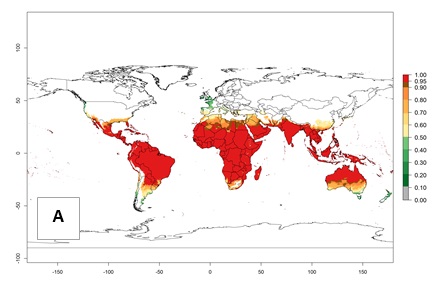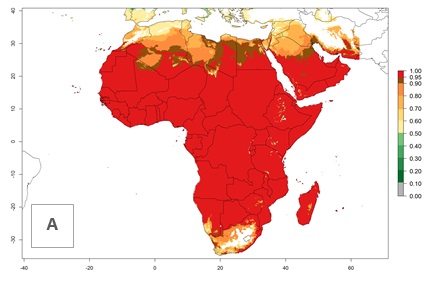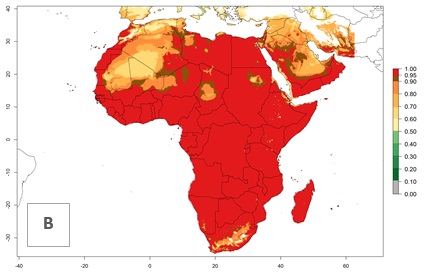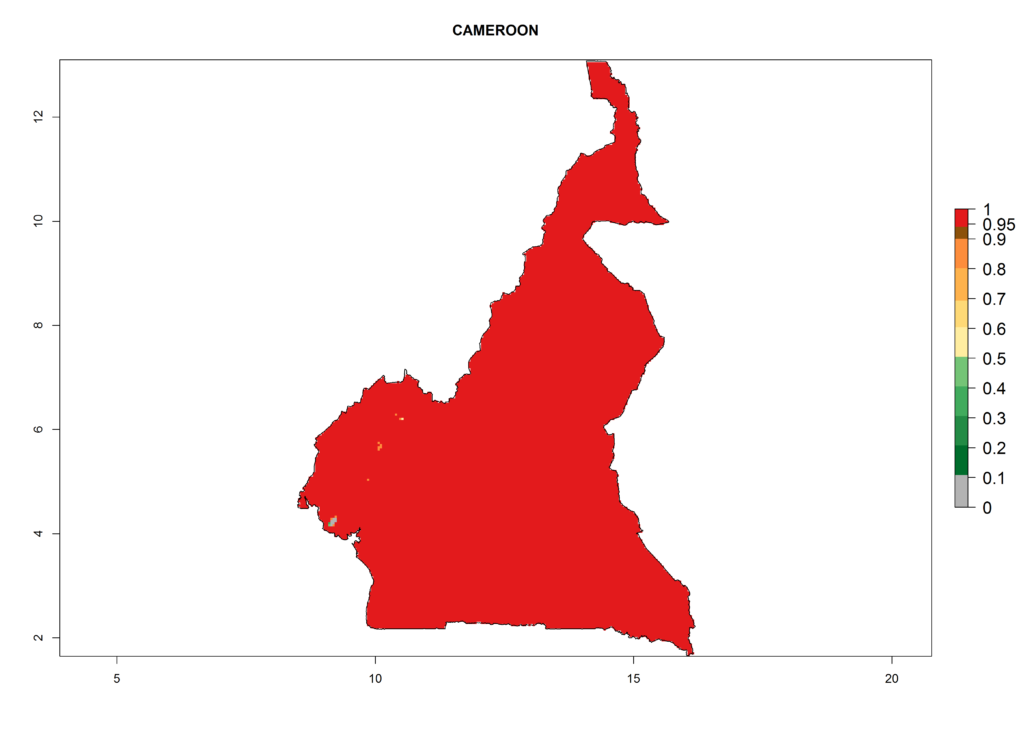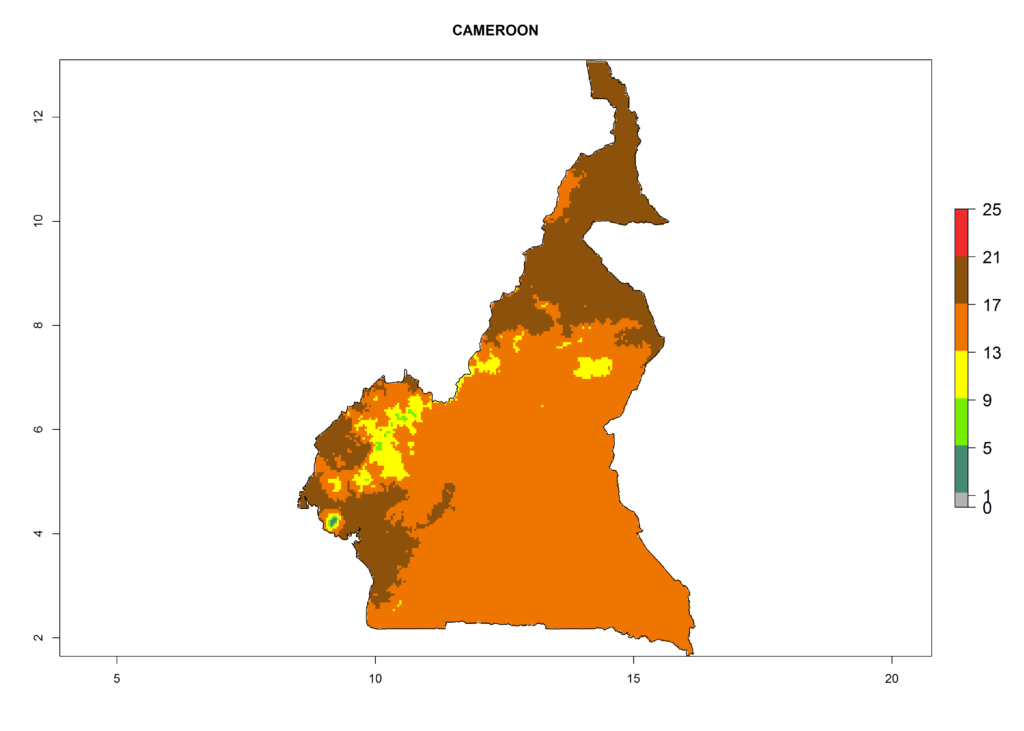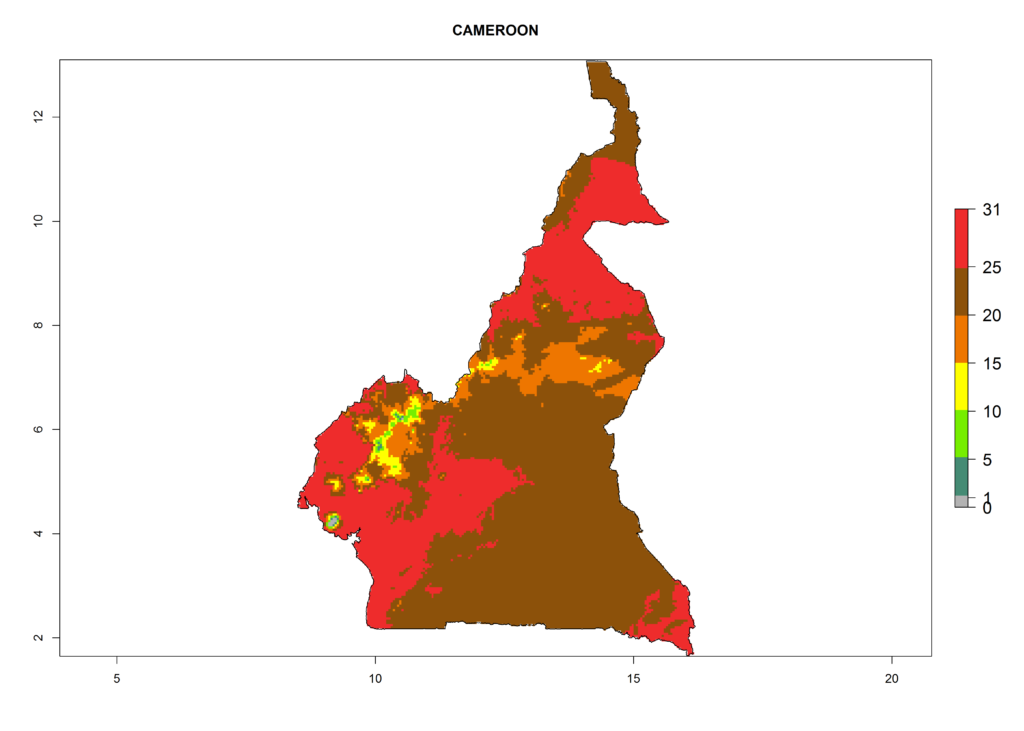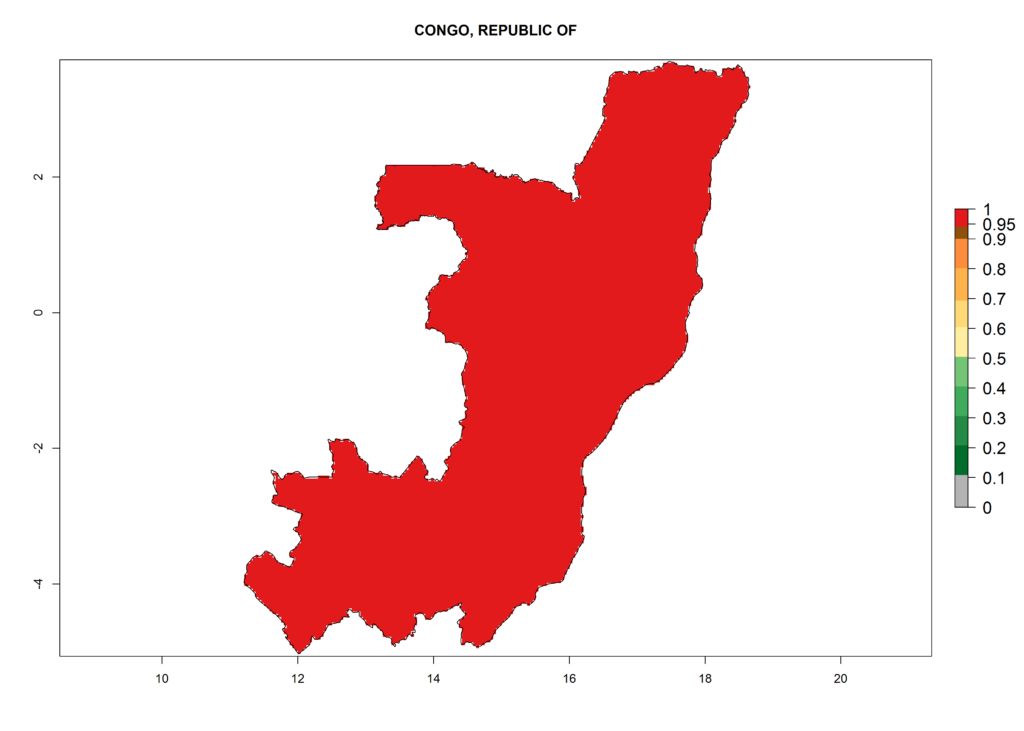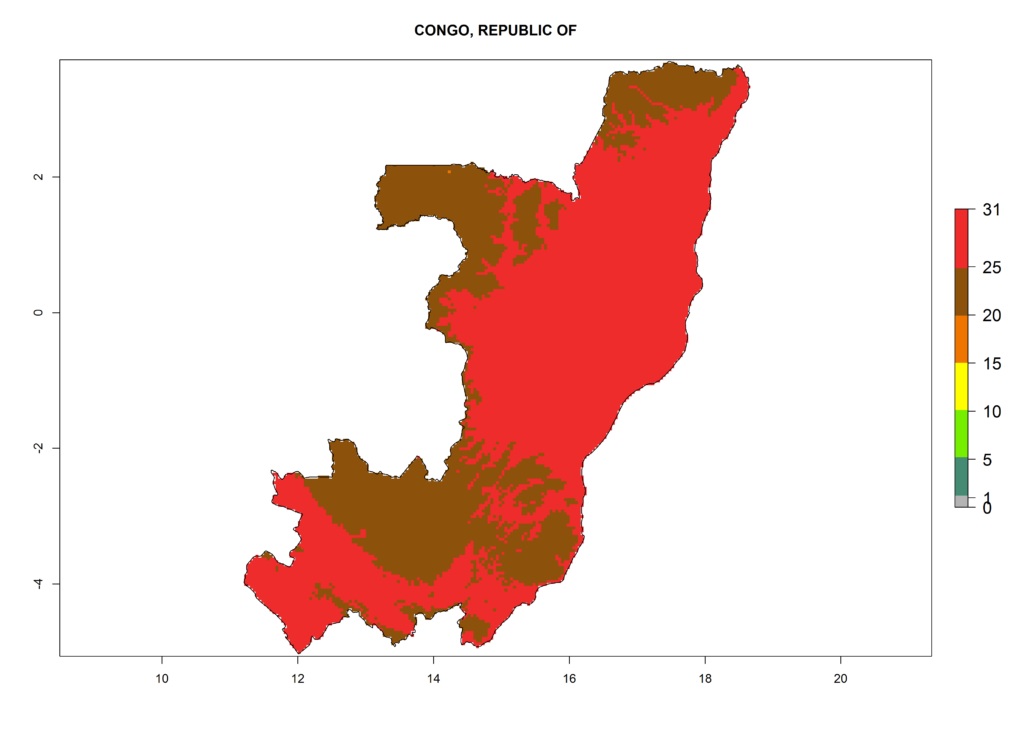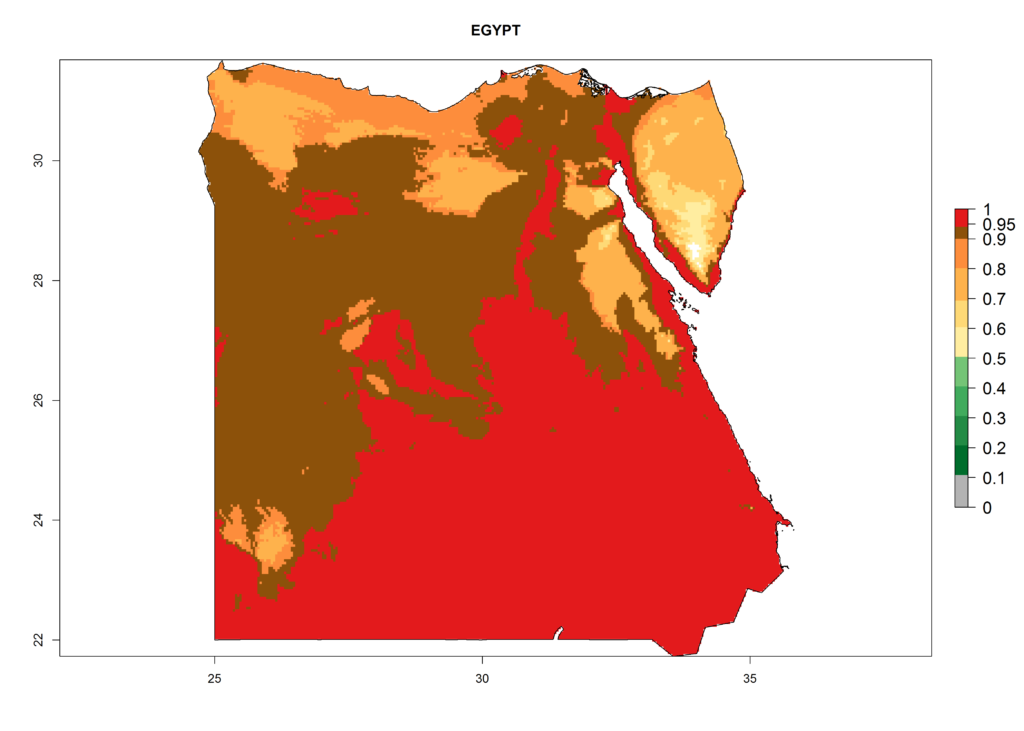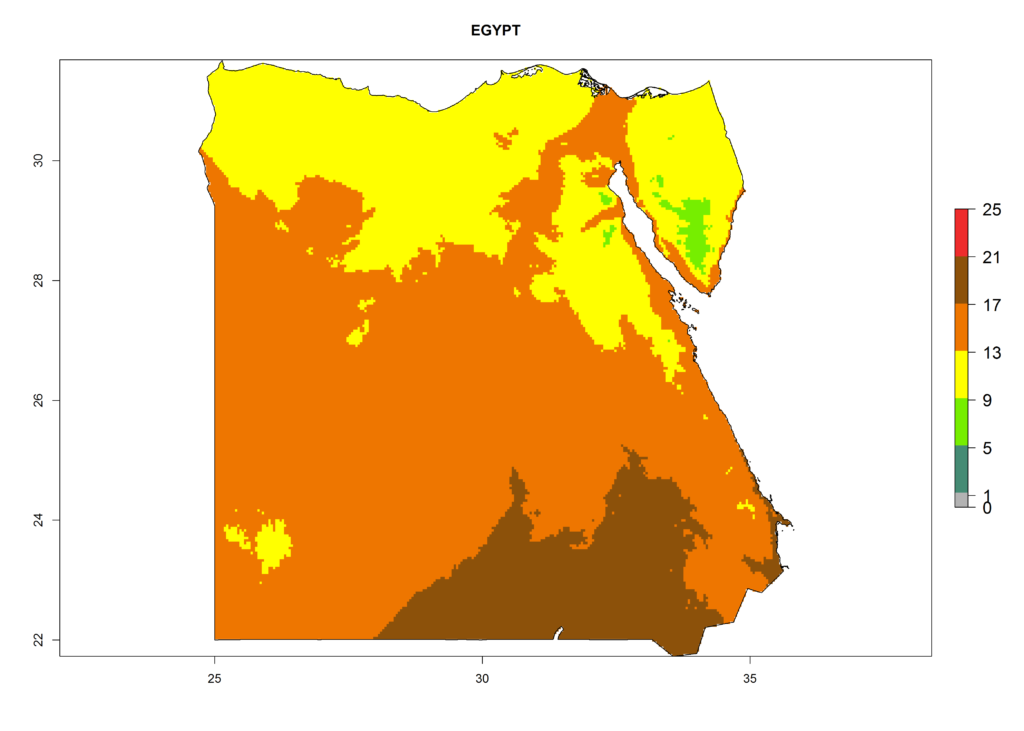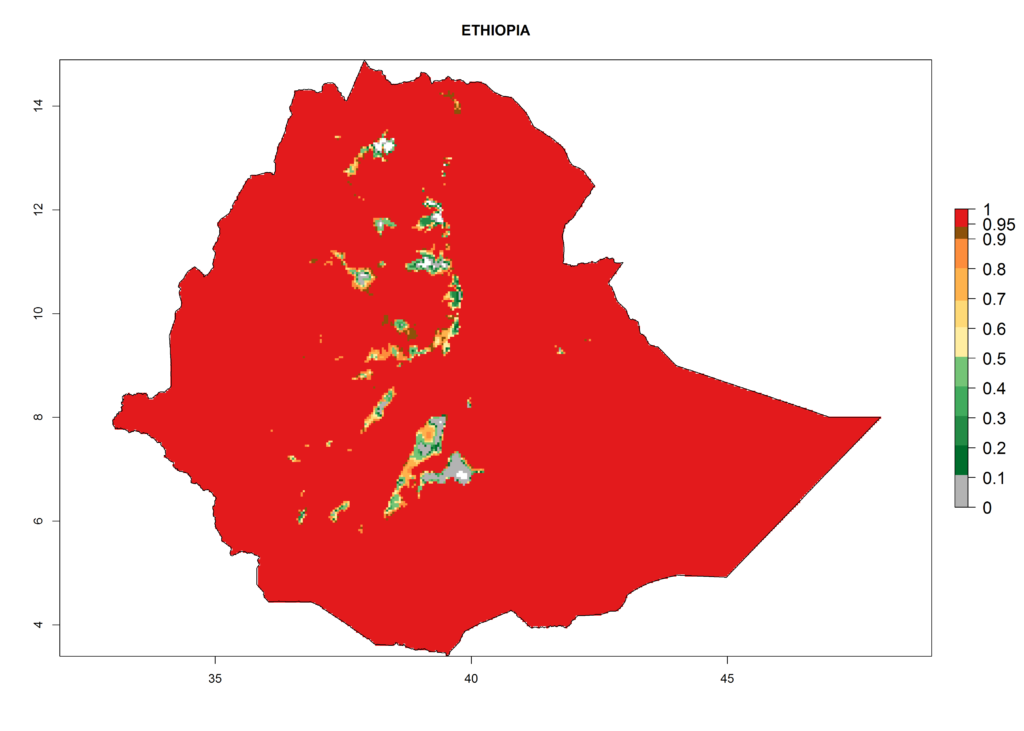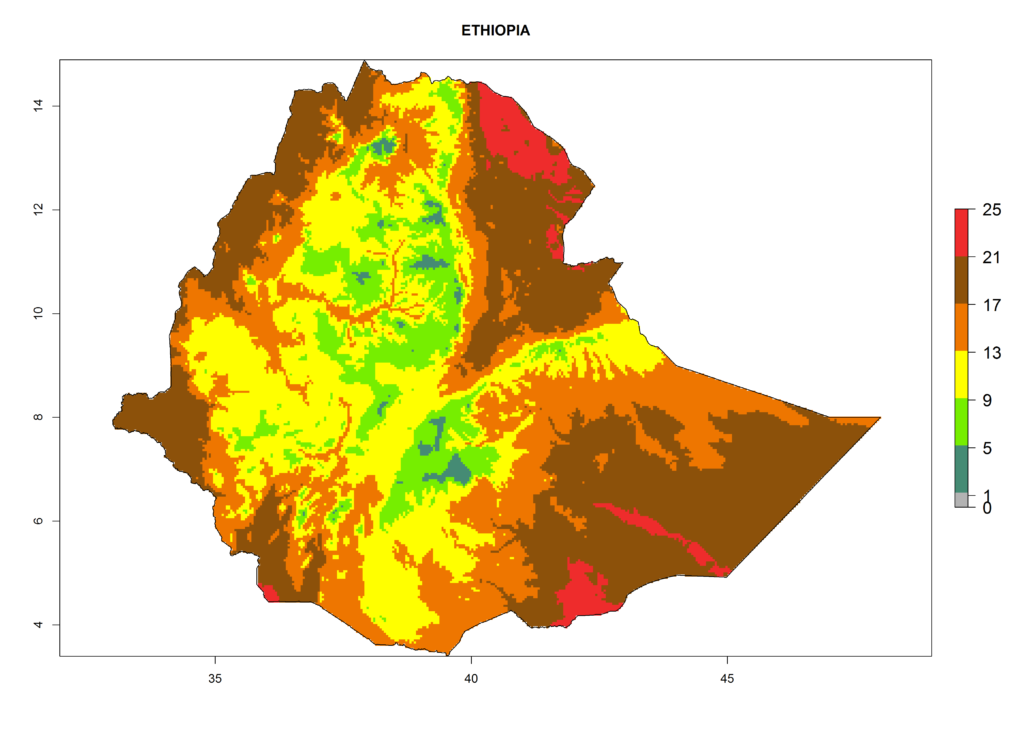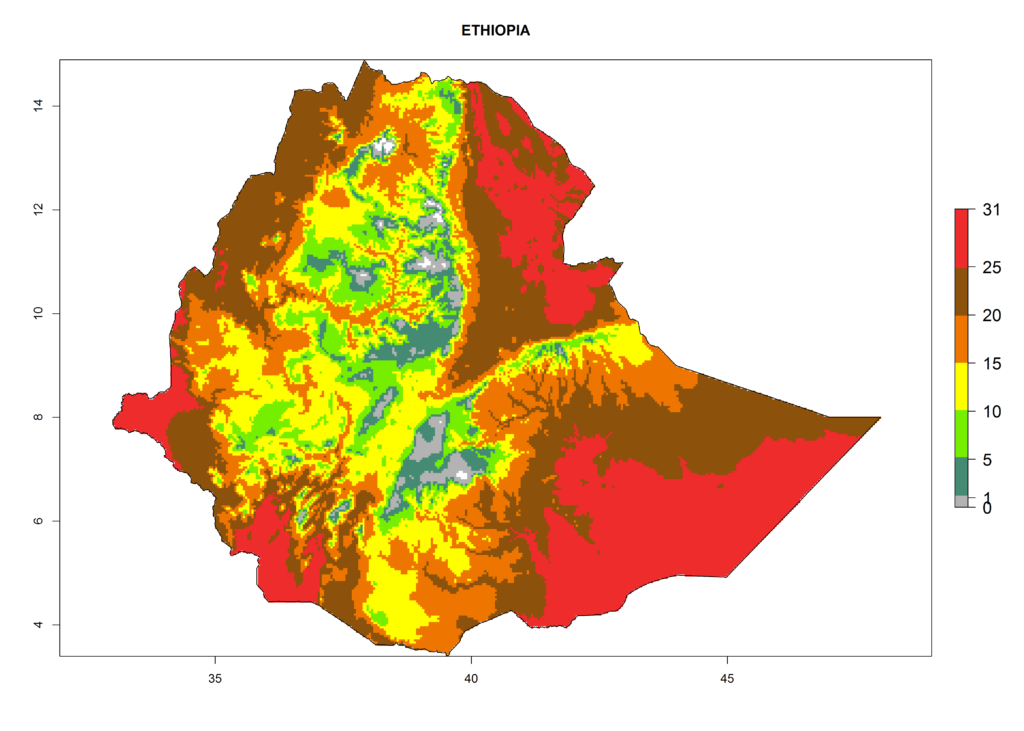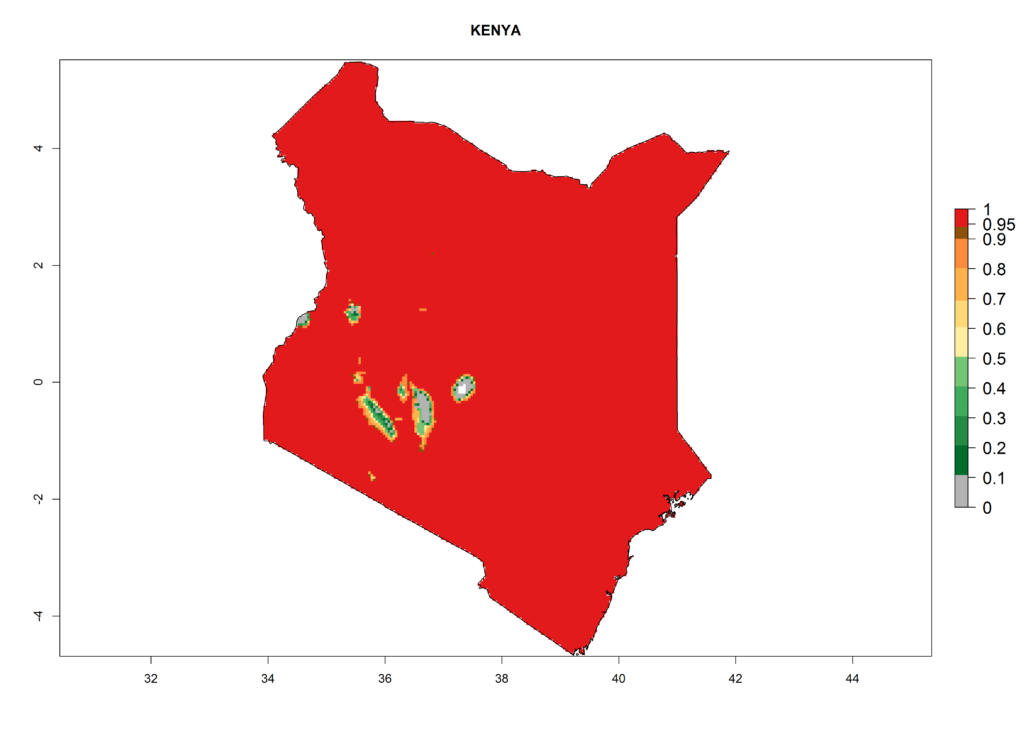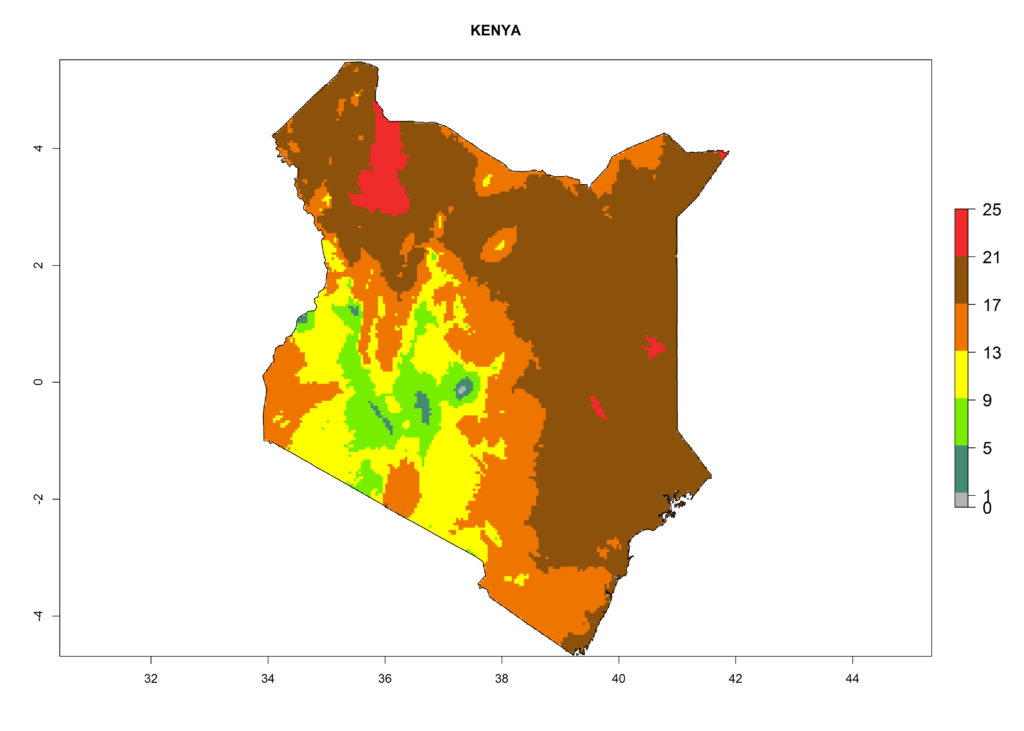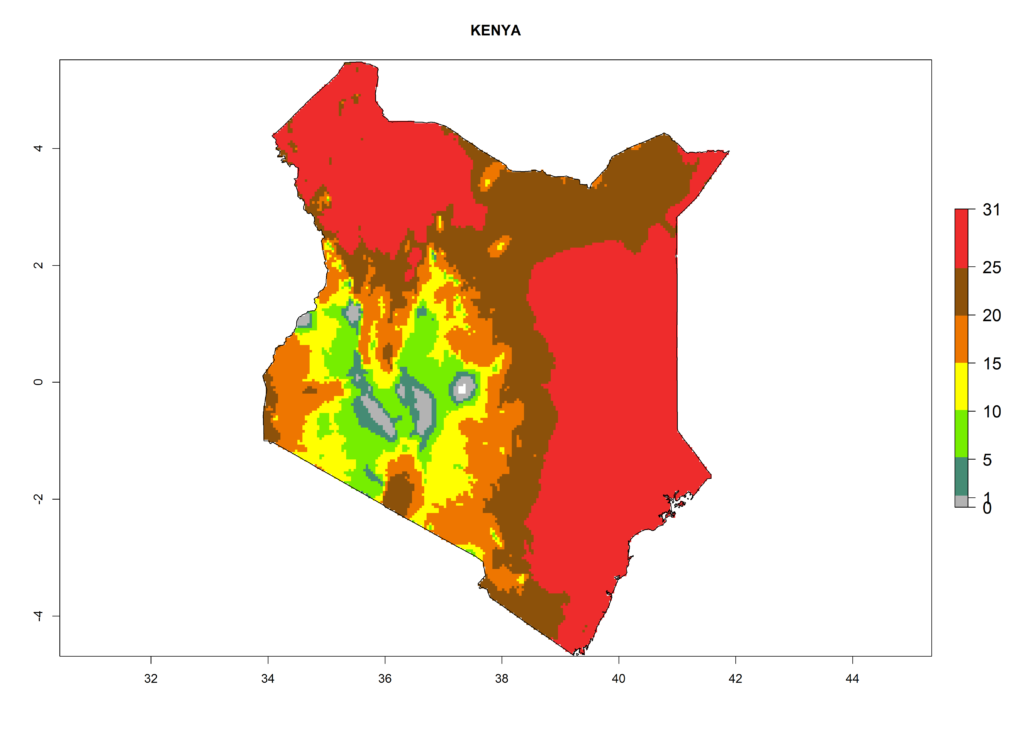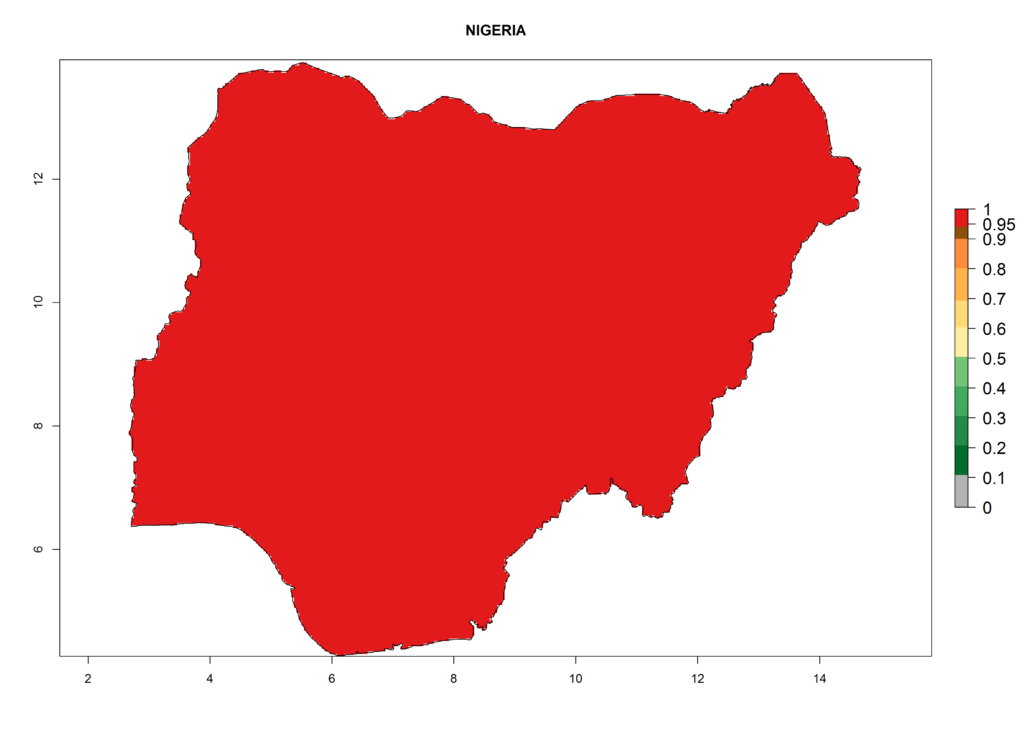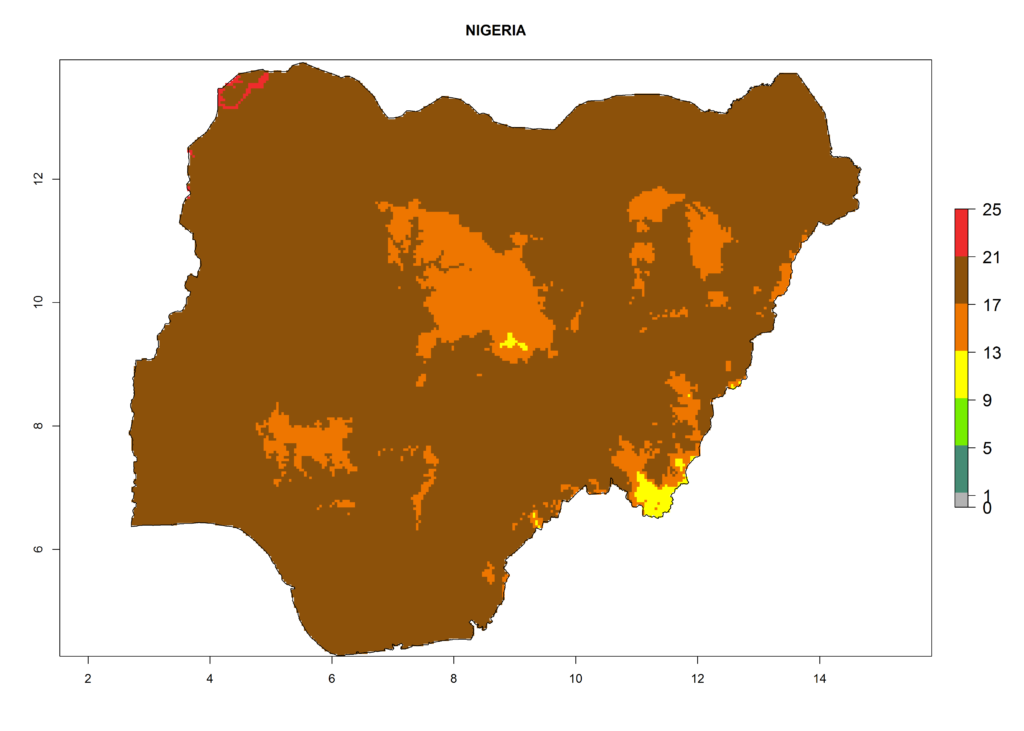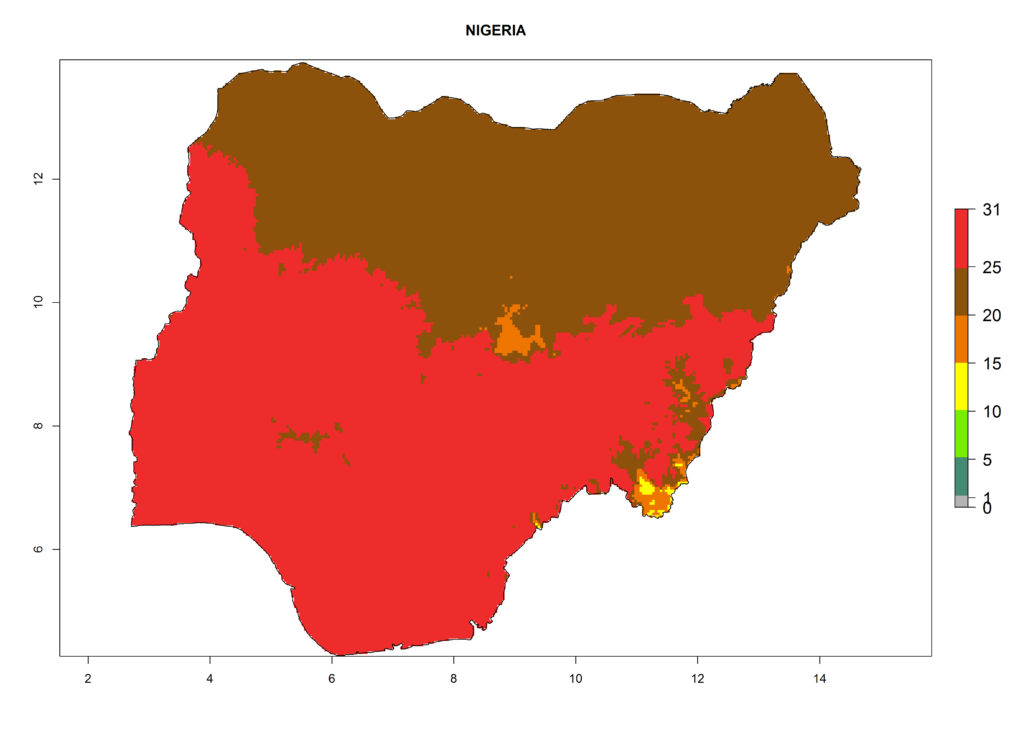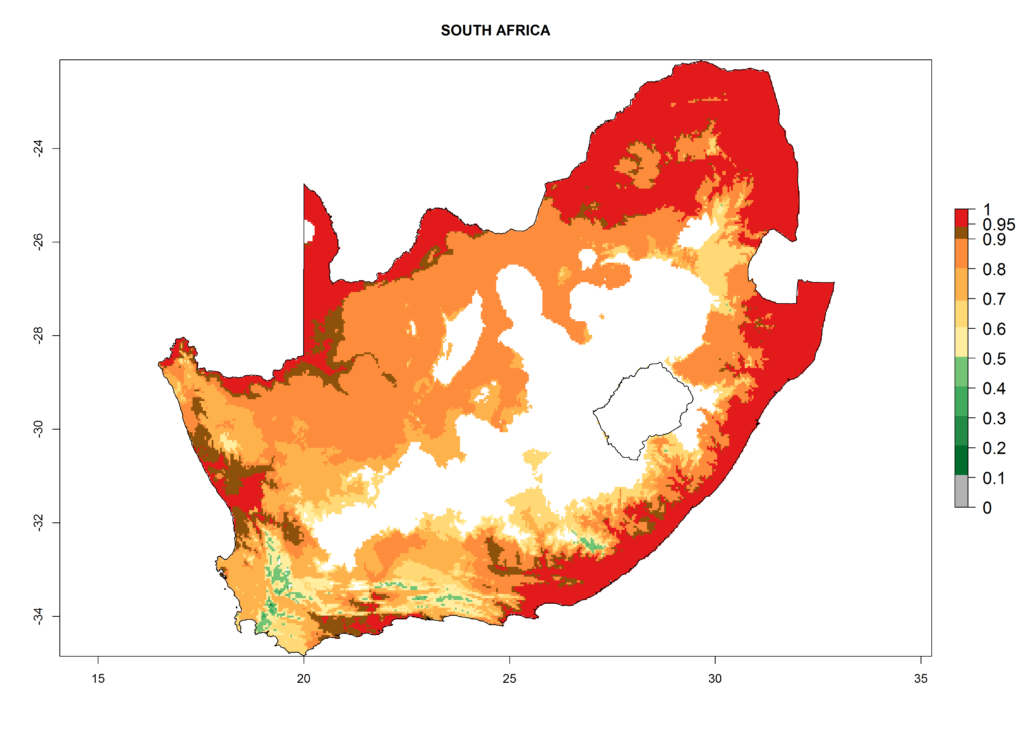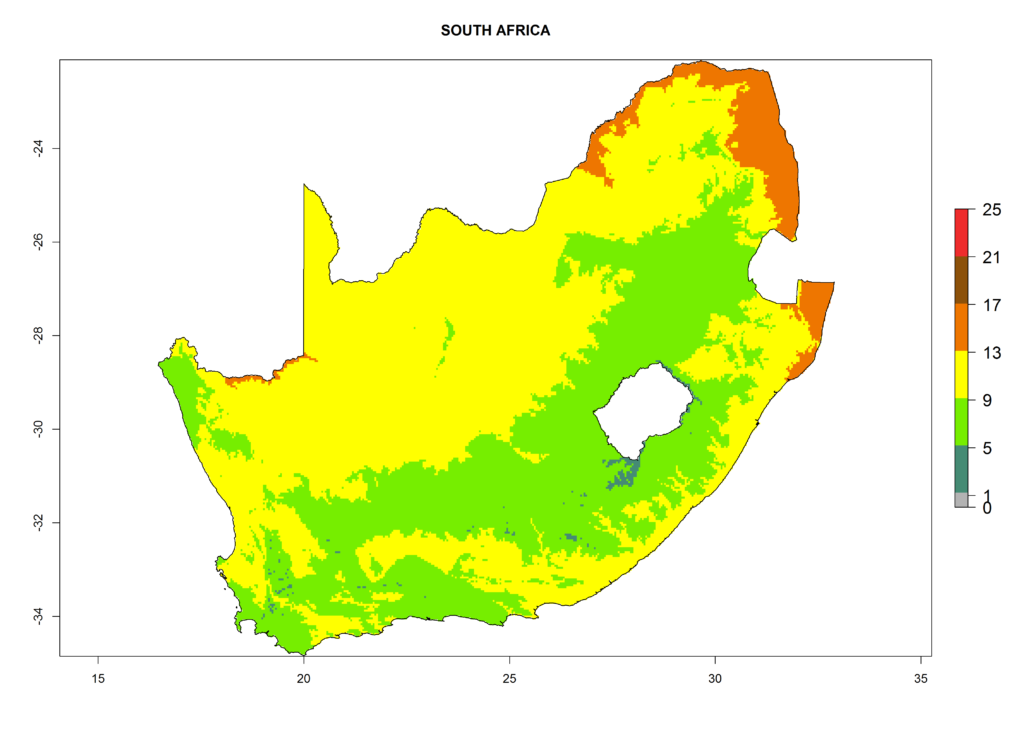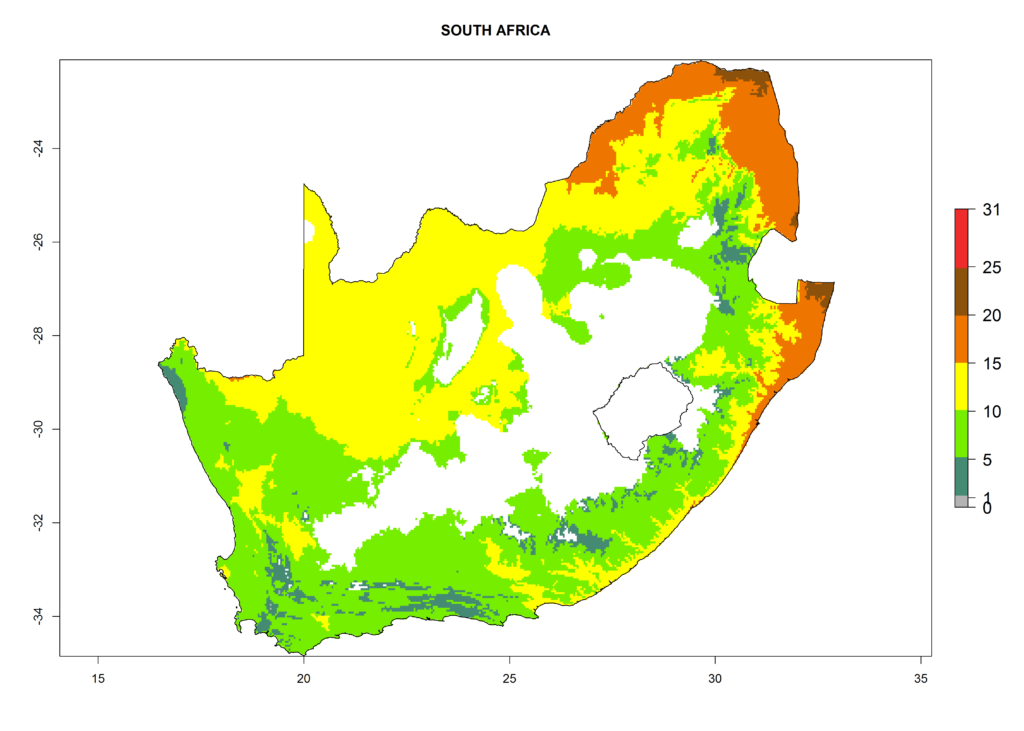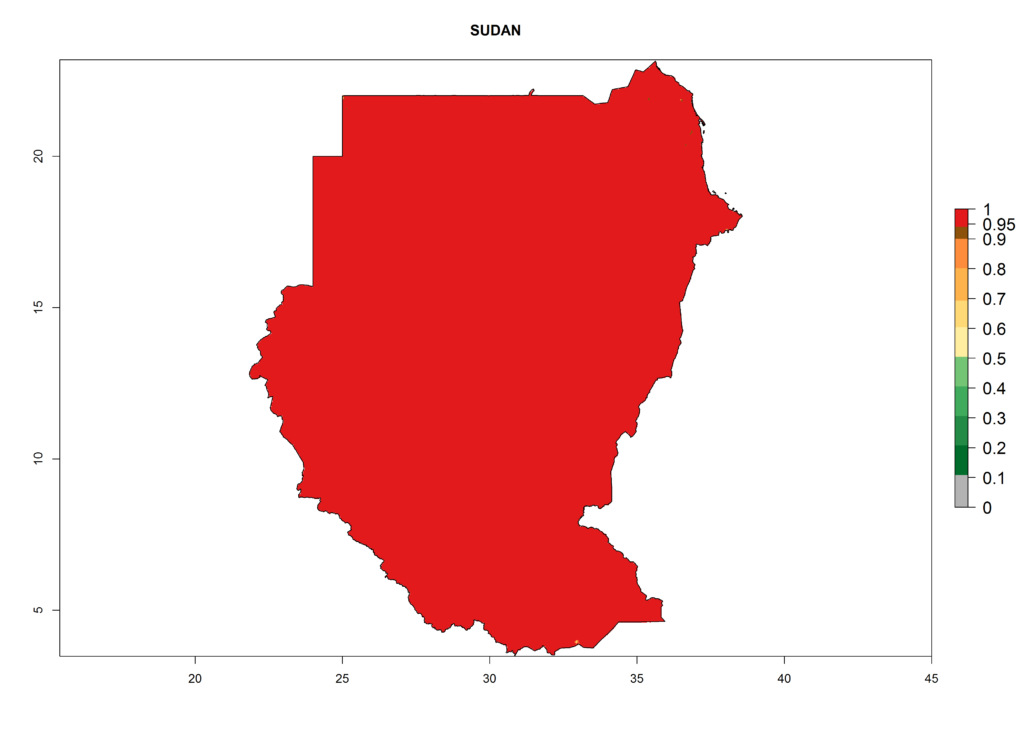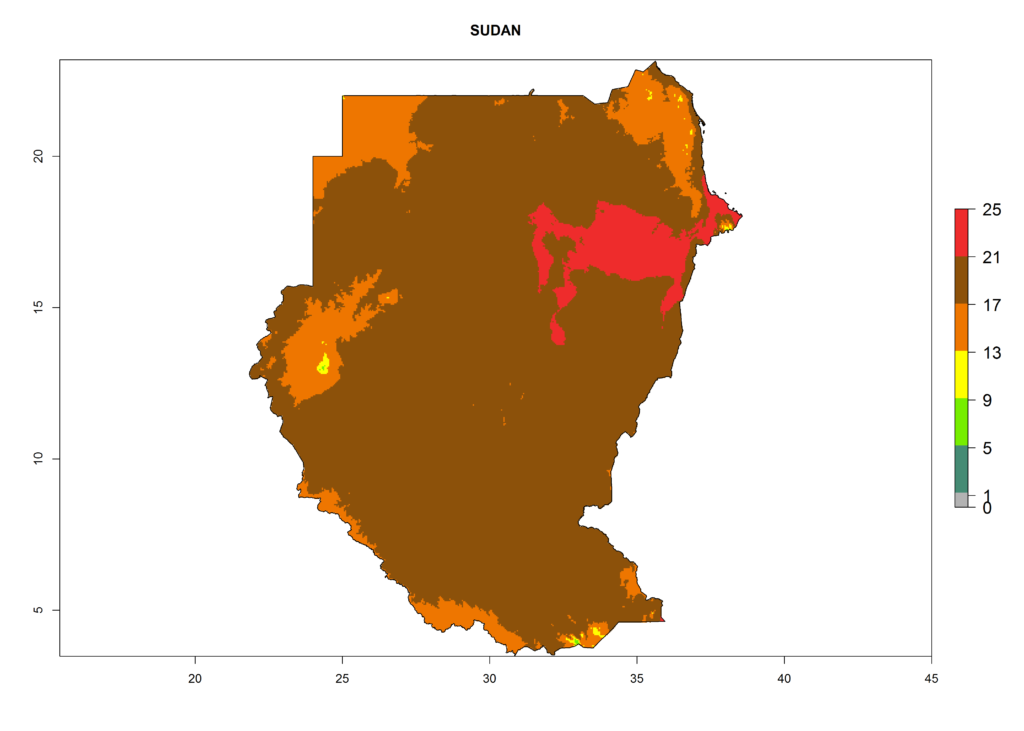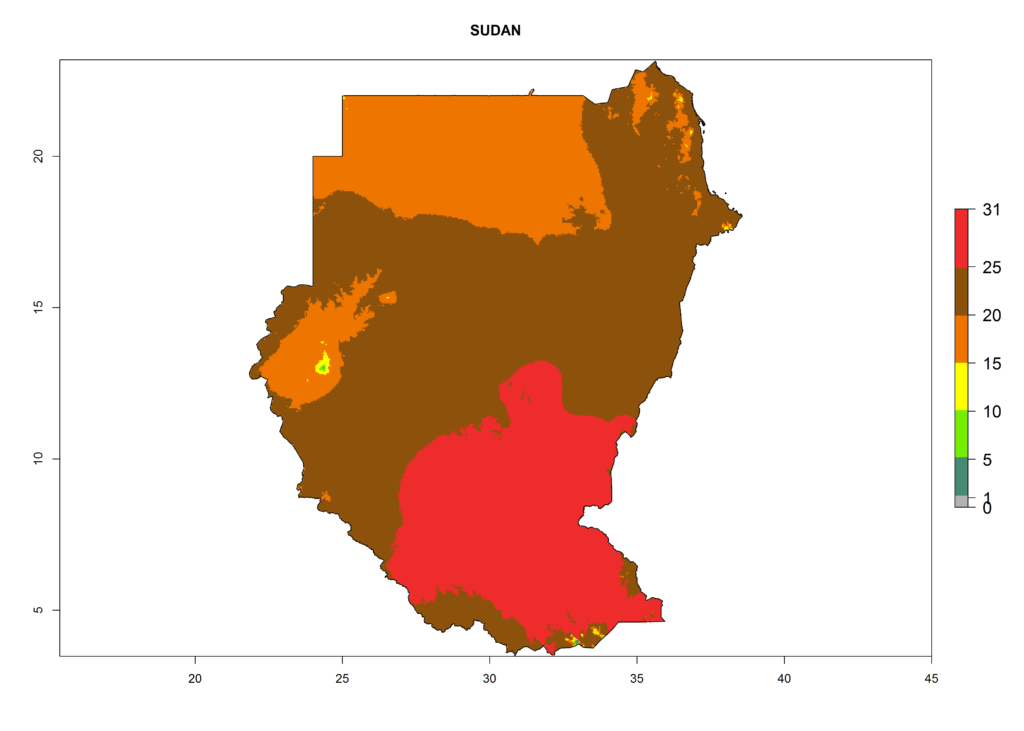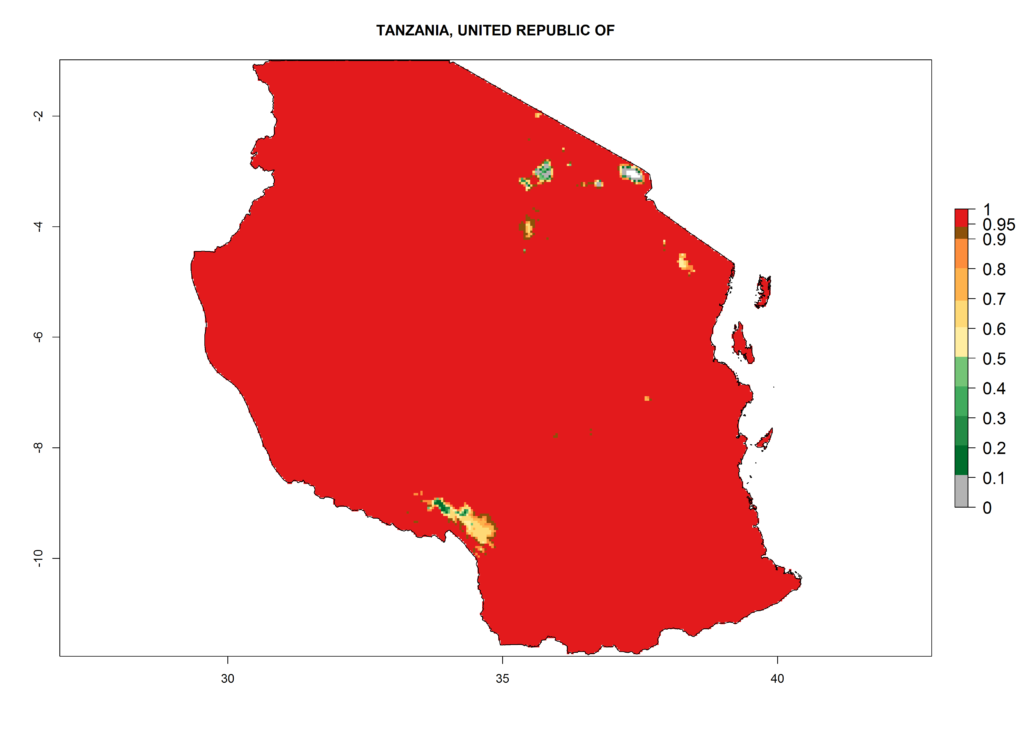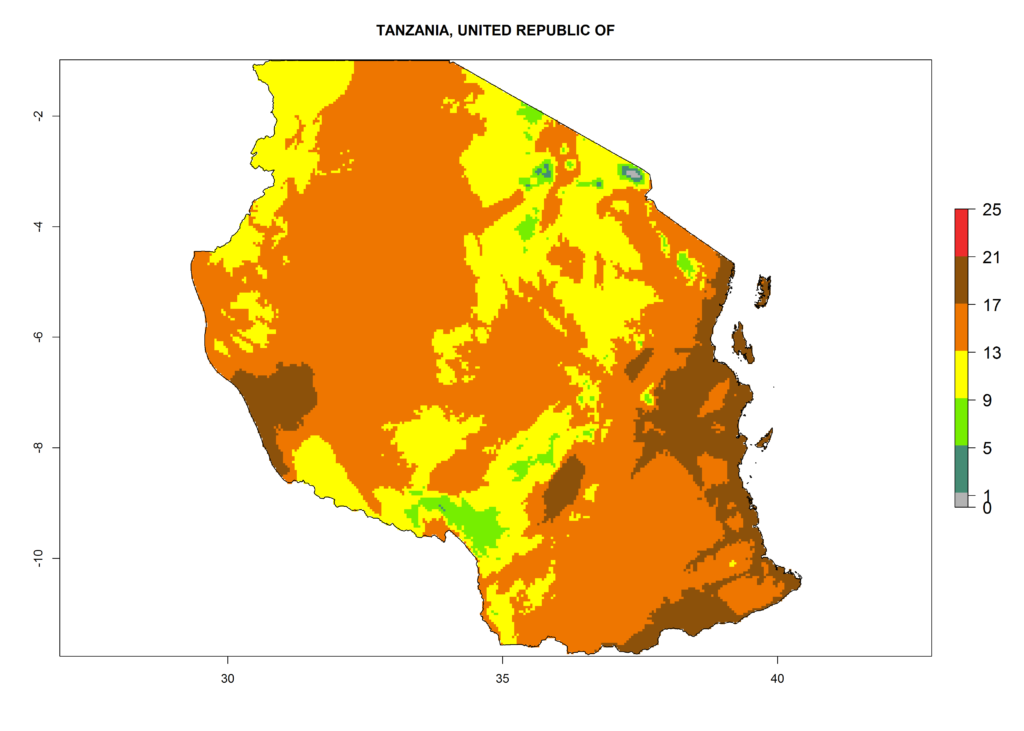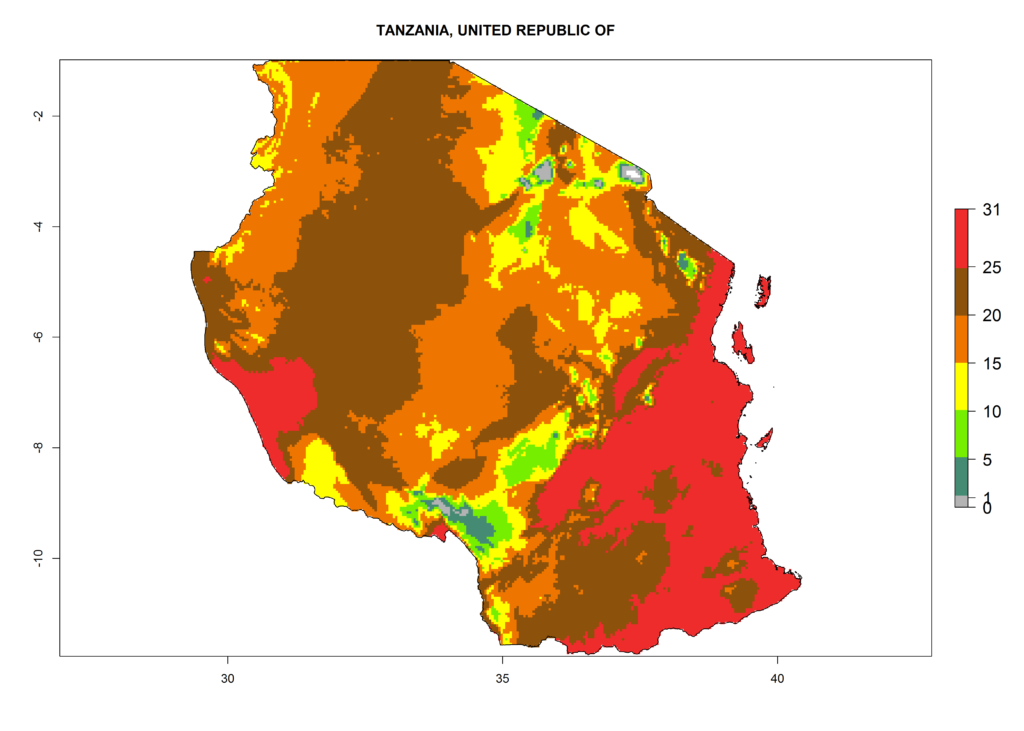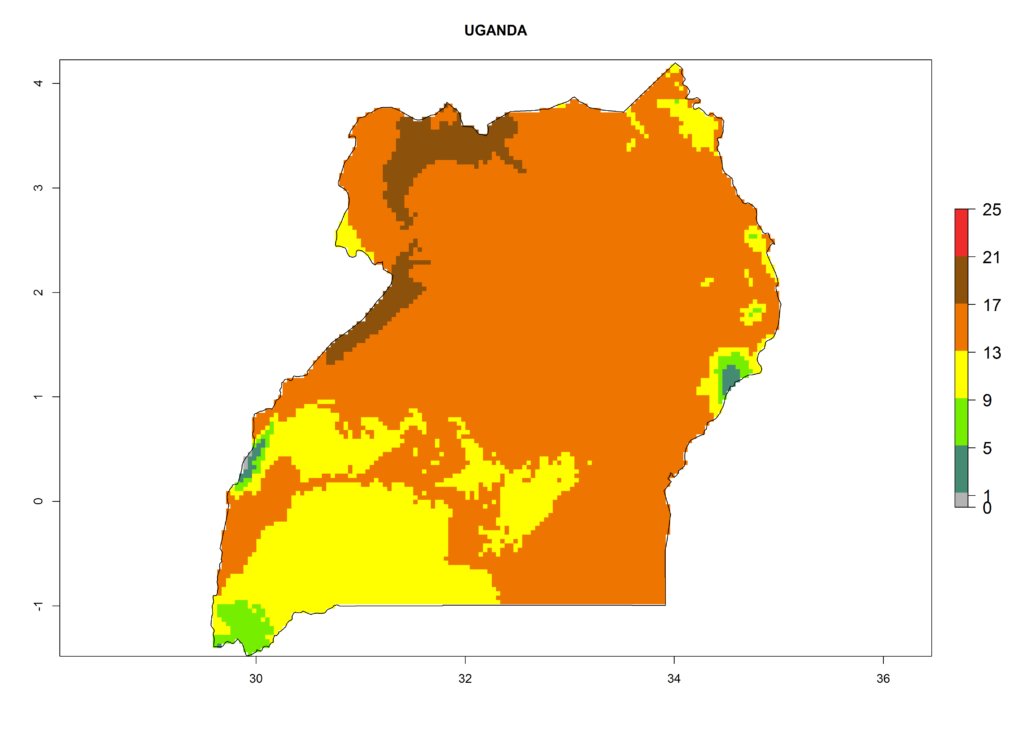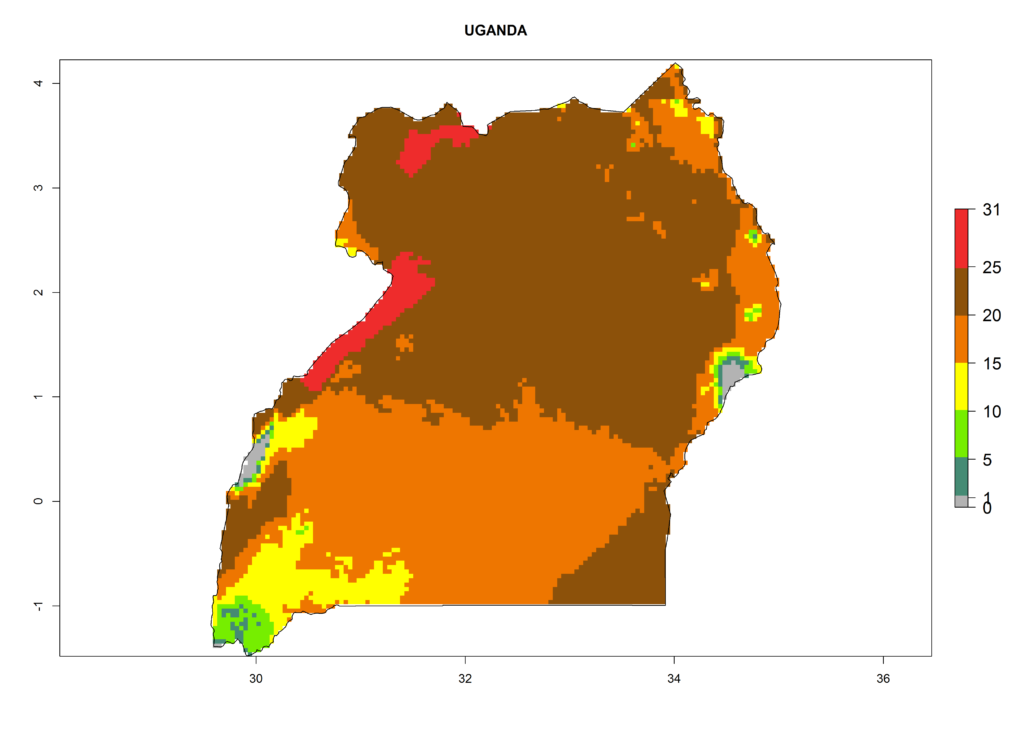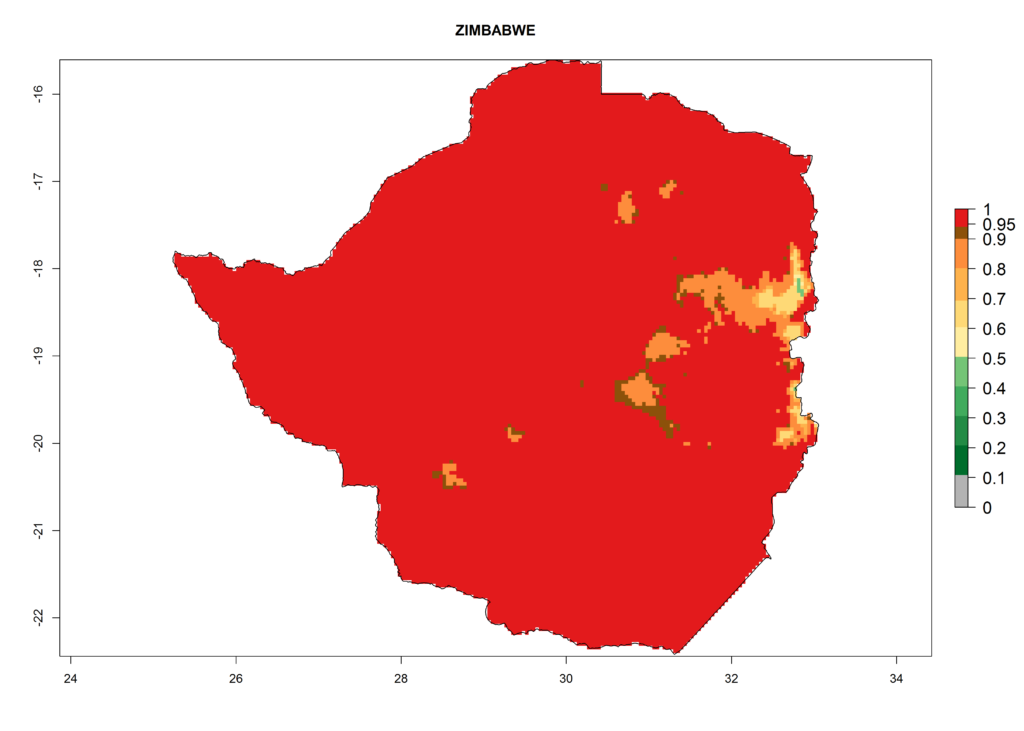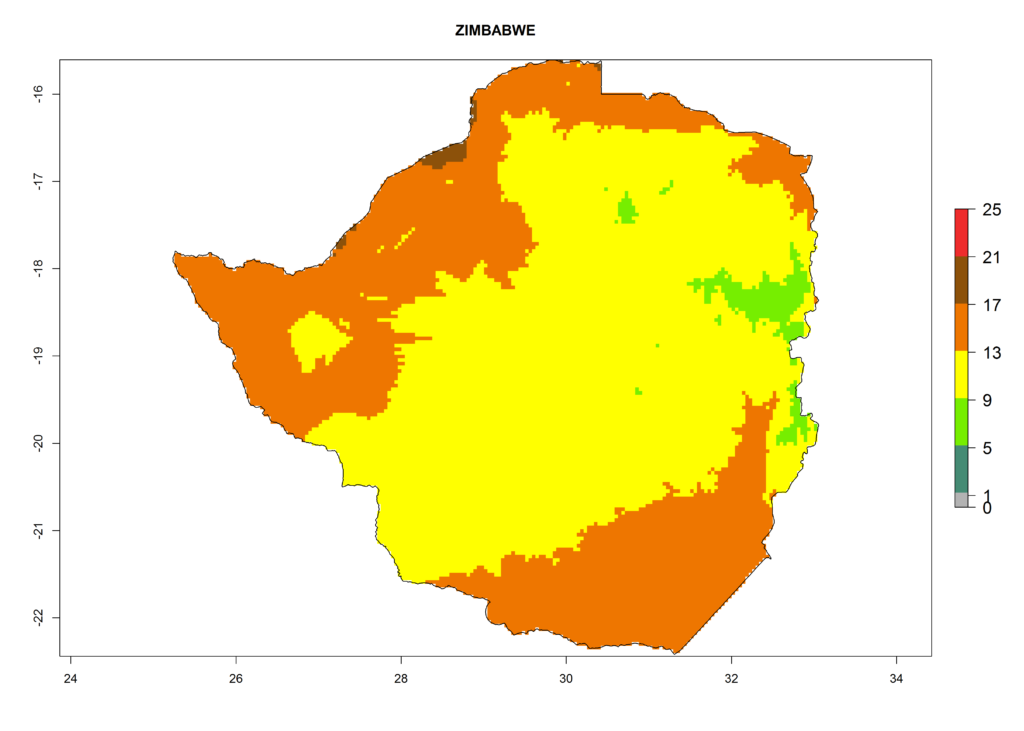4.3. 2 Vegetable Pests /Vegetable leafminer, Liriomyza sativae (Blanchard 1938) ![]()
Synonym: Agromyza subpusilla (Frost 1943)
Liriomyza verbenicola (Hering 1951)
Liriomyza pullata (Frick 1952)
Liriomyza canomarginis (Frick 1952)
Liriomyza minutiseta (Frick 1952)
Liriomyza propepusilla (Frost 1954)
Liriomyza munda (Frick 1957)
Liriomyza guytona (Freeman 1958)
Lemurimyza lycopersicae (Pla & de la Cruz 1981)
Taxonomic position: Insecta, Diptera, Agromyzidae
Authors: N. Mujica, D. Alvites, P. Carhuapoma, & J. Kroschel
Common names
South American leafminer, vegetable leafminer, serpentine vegetable leafminer, cabbage leafminer, tomato leafminer (English), minador de la higuerilla, minador de las hojas de col, minador del tomate, minador serpentina de las hortalizas (Spanish), mineuse maraichère (French)
Hosts
Liriomyza sativae is a polyphagous pest of many vegetable and flower crops. It has been recorded from nine plant families, although its preferred hosts tend to be in the Cucurbitaceae, Fabaceae, and Solanaceae families. The main crops attacked are these: Cucurbitaceae: cantaloupe (Cucumis melo L.), cucumber (C. sativus L.), squash (Cucurbita pepo L.), and butternut (C. moschata Duch); Euphorbiaceae: castor (Ricinus communis L.); Fabaceae: pigeon pea [Cajanus cajan (L.) Millsp.], soybean (Glycine max L.), Lupinus sp., alfalfa (Medicago sativa L.), Melilotus alba Desr., lima bean (Phaseolus lunatus L.), bean (P. vulgaris L.), Vigna luteola (= repens) (Jacq.) Benth, and cowpea (Vigna unguiculata (L.) Walp); Solanaceae: pepper (Capsicum annuum L.), tomato (Lycopersicon esculentum L.), eggplant (Solanum melongena L.), and potato (Solanum tuberosum L.); Brassicaceae: Brassica spp.; and Malvaceae: cotton (Gossypium sp.). Some ornamentals are also host plants—for example, Chrysanthemum spp. (Spencer 1981).
Detection and identification
Adults and larvae of L. sativae damage the plant foliage. Feeding punctures appear on the upper side of the leaves as white speckles 0.13–0.15 mm in diameter. Oviposition punctures are smaller (0.05 mm) and are more uniformly round. Foliage punctures for oviposition or feeding activity may cause a stippled appearance on foliage, but this damage is slight compared with the leaf-mining activity of larvae. Mines are usually white with dampened black and dried brown areas. The irregular mine increases in width from about 0.25 mm to about 1.5 mm as the larva matures (Photo 1A, B). Larvae are often easily visible within the mine where they remove the mesophyll between the leaf surfaces.
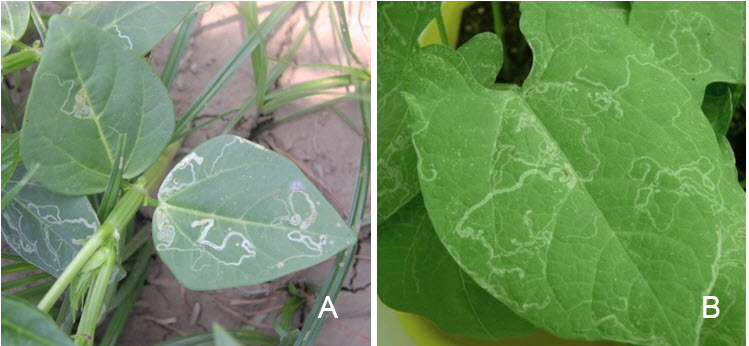
Morphology
Egg
Eggs are off-white, slightly translucent, and about 0.2–0.3 x 0.10–0.15 mm in size (Photo 2A).
Larva
Larva is headless maggot up to 3 mm in length when fully grown. First instar larvae are colorless on hatching, turning pale yellow-orange. Later instars are yellow-orange (Photo 2B). Larvae (and pupae) have a pair of posterior spiracles shaped like a triple cone. Each posterior spiracle opens by three pores, one pore located toward the apex of each cone.
Pupa
The pupa is oval, slightly flattened ventrally, 1.3–2.3 x 0.5–0.75 mm, with variable color, pale yellow-orange often darkening to golden brown (Photo 2C).
Adult
Adults are very small (1.3–2.3 mm in body length, up to 1.7 mm in female with wing length), grayish-black, compact-bodied. Females are slightly larger than males. The mesonotum is shiny black to the edge of a bright-yellow scutellum; the face, frons, and third antennal segment are bright yellow (Photo 2D).

Biology
All Agromyzidae species included in this Atlas have a very similar biology. Females use their ovipositor to puncture the host plant, causing lesions that serve for feeding (by both male and females flies) or oviposition. Feeding punctures of Liriomza species are rounded and appear as white speckles of the upper leaf surface. The eggs are inserted just below the surface. There are three larval stages that feed within the leaves. The larvae of L. sativae leave the plant to pupate (i.e., many pupae may be found in crop residues, in the soil, or on the leaf surface).
Temperature-dependent development
L. sativae completed its development from egg to adult in all temperatures at 15°–30°C but not at 10ºC or 35°C (see Annex 7.3.10). Leafminer total development was three times longer at 15ºC (40.2 days) than at 30ºC (12.4 days). Estimated lower threshold for immature stages were 12.8ºC (egg), 8.9ºC (larvae), and 6.8ºC (pupae). For entire immature stage, lowest mortality occurred at 20°–25ºC (57%) and the highest at 15ºC (96%). At 35ºC, all pupae died before adults emerged. Pupae were more vulnerable to unfavorable temperatures compared with other stages. Optimal temperature for survival was 20°–30ºC (37–43% survival of the entire immature stage). Female longevity was almost three times longer at 15ºC (19 days) than at 30ºC (7 days). Significant differences between male and female adults were only observed at 20ºC, with female longevity almost twice as long as males. The lowest senescence rate was observed within the temperature range of 15°–25ºC. Highest fecundity was found at 25ºC (220 offspring/female).
The established functions (see Annex 7.3.10) were used to estimate the life-table parameters of L. sativae and to build an overall deterministic phenology model. Predicted life-table parameters at constant temperatures show that L. sativae populations develop within the temperature range of 18°–32°C. The intrinsic rate of natural increase (rm) augments almost linearly with increasing temperature to reach a maximum at 25ºC (0.154) and then decreased sharply at 32ºC (0.083). The negative r values below 17ºC and above 32ºC indicate that population size is decreasing due to high mortality and few reproduction. Similarly, finite rate of increase for leafminer fly peaked at 25ºC (λ=1.038) and was smallest when exposed to 15ºC (λ=0.97) and 35ºC (λ=0.92); λ values of <1 indicate that the population is decreasing. The highest values for both reproductive parameters (gross reproductive rate and net reproductive rate, Ro) were found at 25ºC. The shortest mean generation time (T) and doubling time (Dt) were observed at 32ºC (17.0 days) and 25ºC (4.05 days), respectively. The optimum temperature for overall population growth ranged between 25°C and 30ºC.
Deterministic simulation of life-table parameters under prevailing temperature conditions of two agro-ecological zones of the Peruvian coast showed that arid tropical (Tumbes: 3°33′ 38″S, 80°28’00″W, 25 masl, with a mean annual precipitation of 175 mm and mean temperature of 27ºC) presents better temperature conditions than arid subtropical (La Molina: 12º 05′ S, 76º 57′ W, 250 masl, with a mean annual precipitation of 6.4 mm and mean temperature of 19.7ºC) for vegetable leafminer fly population increase in all evaluated seasons. According to T for the different seasons, we predicted 16.2 and 10.3 generations per year in tropical (Tumbes) and subtropical (La Molina) agro-ecologies.
Means of movement and dispersal
The ability of adult flies to fly is limited. Dispersal over long distance is through larvae and pupae in infested planting material of host plants. Cut flowers can also present a danger as a means of dispersal. It should be noted that, for example, the vase life of chrysanthemums is sufficient to allow completion of the life cycle of the pest.
Economic impact
L. sativae is reported as economically damaging on a wide range of vegetables in East Africa. Severe crop damage has been reported in snow peas, sugar snap peas, French beans, runner beans, okra, eggplant, tomatoes, and indigenous vegetables (Amaranthus, black nightshade, spider plant), and field crops like local beans and potatoes. Yield losses range from 10% to 100%. Serious damage has also been reported on cut flowers and passion fruit. In the US, L. sativae is a serious pest in vegetables, including tomato, potato, and cucurbits. In the European Plant Protection Organisation (EPPO) region, it has the potential to become a major pest of a wide variety of ornamental or vegetable crops grown under glass or as protected crops. Tomatoes can tolerate a 30% infestation of pre-bloom leaves and 60% post-bloom. Losses of up to 70% in tomato crops have been reported. Cucurbit crops severely attacked in the seedling stage by L. sativae can be totally destroyed. Damage is caused by larvae mining into leaves and petioles. The photosynthetic ability of the plants is often greatly reduced as the chlorophyll-containing cells are destroyed. Severely infested leaves may fall, exposing plant stems to wind action, and flower buds and developing fruit to scald. In young plants and seedlings, mining may cause considerable delay in plant development, leading to plant loss. The presence of unsightly larval mines and adult punctures in the leaf palisade of ornamental plants can further reduce crop value and rejection.
Geographical distribution
Native to the Americas, this insect is widespread over North, South, and Central America. It has been found in the Caribbean Islands, Africa, some Pacific Islands, and some Asian countries. It has been introduced into Europe, usually via imports for glasshouse cultivation (Crop Protection Compendium 2013).
| Africa | Cameroon, DR Congo (intercepted by France on Brassica), Ethiopia (intercepted by Belgium, the Netherlands, and UK on consignments of vegetables), Kenya, Nigeria, Uganda, Tanzania, South Africa (intercepted in France on basil), Sudan, Zimbabwe |
| Asia | China (Anhui, Fujian, Guangdong, Hainan, Hebei, Henan, Hubei, Hunan, Shandong, Shanghai, Shanxi, Sichuan, Xinjiang, Yunnan, Zhejiang), outside in southern provinces and in greenhouse in northern regions; India (Uttar Pradesh), Indonesia (Java), Iran, Israel, Japan (Honshu, Kyushu, Ryukyu Archipelago), Jordan, Malaysia (peninsular Malaysia), Oman, Sri Lanka, Thailand, Turkey (protected crops), Uzbekistan, Vietnam, Yemen |
| Europe | Absent, intercept only |
| North America | Canada (under greenhouse in Ontario), USA (Alabama, Arizona, Arkansas, California, Florida, Georgia, Hawaii, Indiana, Louisiana, Maryland, New Jersey, Ohio, Pennsylvania, South Carolina, Tennessee, Texas); outside in southern and western states; in glasshouses in Ohio, Maryland, Pennsylvania |
| Central America and the Caribbean | Antigua and Bermuda, Bahamas, Barbados, Costa Rica, Cuba, Dominica, Dominican Republic, Guadeloupe, Guatemala, Honduras, Jamaica, Martinique, Mexico, Montserrat, the Netherlands Antilles, Nicaragua, Panama, Puerto Rico, St. Kitts and Nevis, St. Lucia, St. Vincent and the Grenadines, Trinidad and Tobago |
| South America | Argentina, Brazil (Ceará, Parana, Pernambuco, Rio de Janeiro, Rio Grande do Norte), Chile, Colombia, French Guyana, Peru, Venezuela |
| Oceania | American Samoa, Australia (Queensland), Cook Islands, Federated States of Micronesia, French Polynesia, Guam, New Caledonia, Northern Mariana Islands, Samoa, Vanuatu |

Phytosanitary risks
Risk mapping analysis predicts a high phytosanitary risk of L. sativae in most of the countries in Central and East Africa. L. sativae has the potential to become a major pest of a wide variety of ornamental or vegetable crops in lowland zones of these countries. This is particularly important for export crops, as most Liriomyza species are considered quarantine pests in the EU and produce exported to Europe has been rejected. In addition to economic damage, this species transmits a number of plant viruses, including Celery mosaic potyvirus.
Risks mapping under current and future climates
Global Risks
Changes in establishment and future distribution
An establishment risk index (ERI)>0.95 reflects well the global distribution of L. sativae under the current climate of the year 2000 (Fig. 2A). Those regions include tropical and most of subtropical zones in North (Florida), Central, and South America; the Caribbean; South and Southeast Asia; southern China (Hainan); and Africa (compare with Fig. 1). L. sativae also occurs in regions with an ERI of 0.7–0.9 (dark-orange zones) as in the U.S. (southern states coastal), Mexico (northern areas), Chile (northern coast), Argentina (central zones), China (subtropical provinces of Guandong and Yunnan), Israel, Jordan, and South Africa. L. sativae is also reported in some temperate zones of North America (Canada, U.S.), Central Asia (Uzbekistan), China (northern provinces), and Japan. Its presence is mostly due to survival and infestations in greenhouses (Fig. 1, yellow points), not to survival under open-field conditions, corresponding to an ERI<0.6 (Fig. 2A, light-orange and green zones).
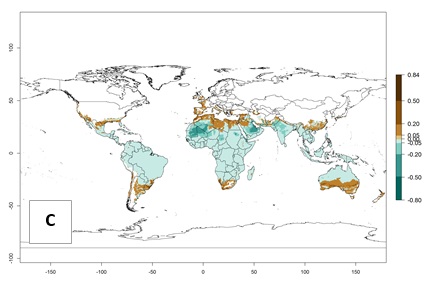 Figure 2. Changes in establishment and potential distribution of the vegetable leafminer fly, Liriomyza sativae, worldwide according to model predictions, using the ERI for the years 2000 (A) and 2050 (B), and changes of the ERI between 2000 and 2050 (C). An ERI>0.7 is associated with potential permanent establishment.
Figure 2. Changes in establishment and potential distribution of the vegetable leafminer fly, Liriomyza sativae, worldwide according to model predictions, using the ERI for the years 2000 (A) and 2050 (B), and changes of the ERI between 2000 and 2050 (C). An ERI>0.7 is associated with potential permanent establishment.
Global predictions for 2050 indicate that L. sativae will continue to be a high-risk pest in most of the tropical areas, but with a slight decrease (<-0.10) in the ERI (Fig. 2B). However, a slight range expansion is observed to warmer subtropical areas such as Southern Africa, southern coast of the U.S. (North America), Uruguay and central Argentina in South America, and central region of China, with a medium establishment potential (ERI>0.6–0.8). Also, an increase in the establishment potential but with a low-risk value (ERI<0.6) is predicted in temperate zones of South America (southern areas of Chile and Argentina), western regions of Europe, and southern Australia, as well as in European Mediterranean countries (Fig. 2C).
Changes in abundance
The mean numbers of generations that might theoretically develop within a year in the year 2000 and year 2050 scenario are illustrated in Figure 3A, B on a global scale. The generation index (GI) for the year 2000 estimates a high number of generations (GI>17) of L. sativae in most of the tropical regions of central and South America, Africa, Asia, and Australia (Fig. 3A). The GI change global map indicates that in most subtropical and tropical regions, an increase of 2–4 generations can potentially be expected, as in North (southern U.S.), Central (Mexico), and South America; Africa; Asia (Middle East, South, and Southeast Asia); southern Europe (Portugal, Spain); and Oceania (Fig. 3C). In temperate regions such as North America (northern U.S.), East Asia, and western Europe, only a slight increase of 1–2 generations per year is expected.
| GI | AI | |
| 2000 | 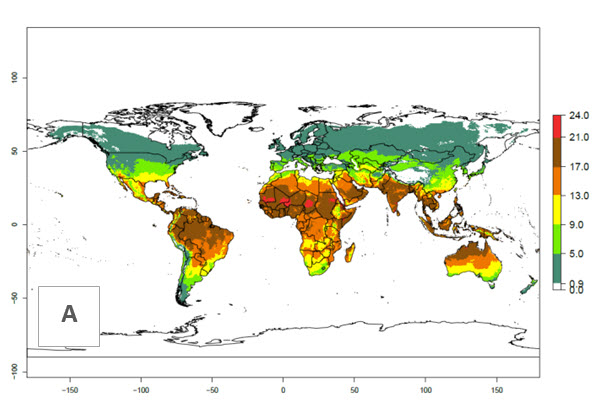 |
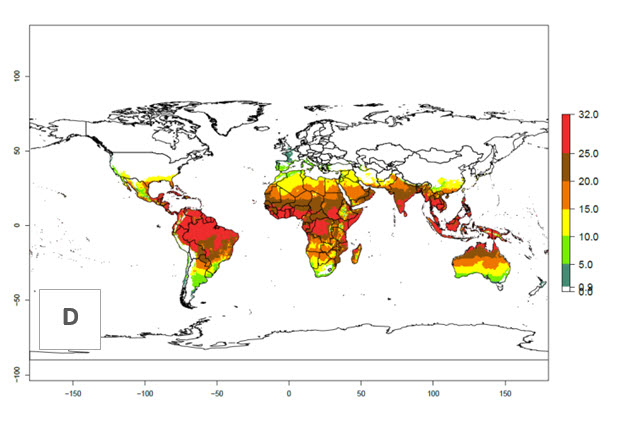 |
| 2050 | 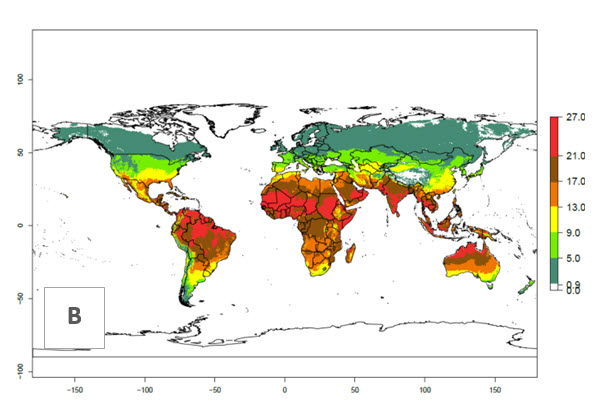 |
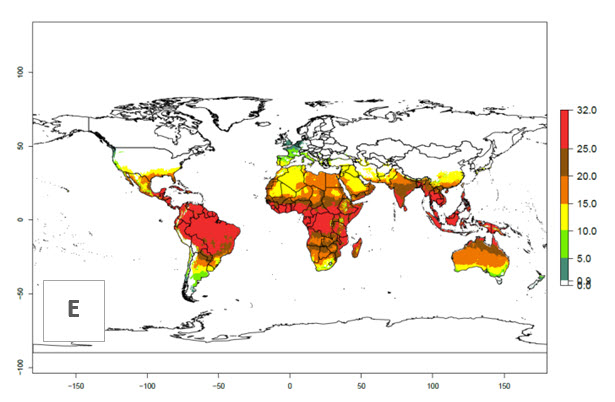 |
| Index change (2000 – 2050) | 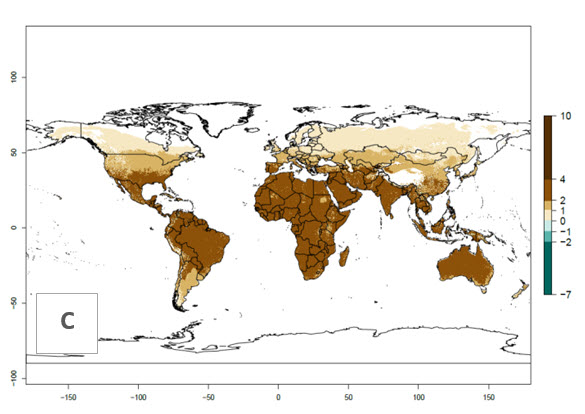 |
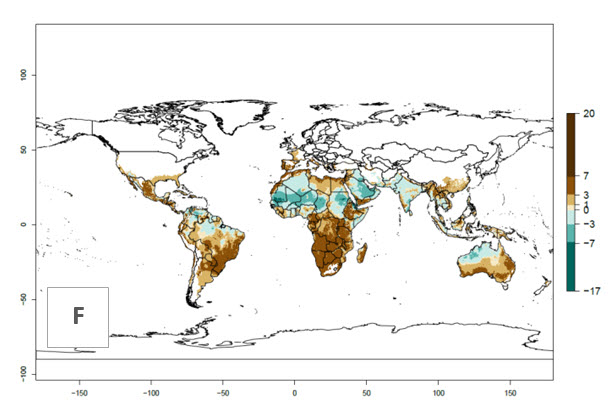 |
Figure 3. Changes in abundance (GI, damage potential) and activity (activity index [AI], potential population growth) of the vegetable leafminer fly, Liriomyza sativae, worldwide according to model predictions, using the GI (A, B) and the AI (D, E) for the years 2000 and 2050, and the absolute index change (C, F).
Globally, simulated GIs gave reasonable predictions when compared with simulated generation numbers. For example, in the tropical northern region (Tumbes: 25 masl, mean annual temperature of 27ºC) and subtropical central region (La Molina: 500 masl, mean annual temperature of 20ºC) of Peru, a mean number of 16 and 10 generations per year has been calculated, respectively. Estimations made by the GI are consistent with these data. The simulated GI 2000 scenario shows higher GI values in the tropical (GI of 13–17, orange zone) than in the subtropical region (GI of 9–13, yellow zone). Additionally, in the subtropical regions of southern China, L. sativae has 15–18 generations throughout the year, which is in line with the predicted values of GI (13–17 generations per year). The GI change between the 2000 and 2050 scenario shows similar number of leafminer fly generations per year (2–4 more per year), but a higher number of leafminer fly generations per year is expected in tropical (GI of 17–21, brown zone) than in subtropical (GI of 13–17, orange zone) regions.
Global maps of the activity index (AI) in year 2000 estimates a high activity (AI>20) of L. sativae in tropical regions of America, Africa, Asia, and Australia (Fig. 3D). Predictions of changes for the 2050 scenario show a high increase in the activity and potential growth by a factor of 7–20 of L. sativae in tropical regions of central and South America, sub-Saharan Africa, and Asia (Fig. 3E, F). Instead, increasing temperature along the equator will potentially reduce L. sativae activity. Also, a low increase in the activity of L. sativae (AI<15) is observed in subtropical warm and cold regions of South America and China as well as in temperate areas like southern and western Europe.
Regional Risks for Africa
Changes in establishment and future distribution
In Africa, L. sativae is actually present in regions in North (Sudan), West (Nigeria), Central (Cameroon and Congo), East (Ethiopia, Kenya, Uganda, Tanzania), and Southern (Zimbabwe and South Africa) Africa (Fig. 1), with an ERI>0.95 (Fig. 4A) (with the exception of South Africa). The pest represents a high risk (ERI>0.95) also for most production areas of other countries of West, East, Central, and Southern Africa. The establishment of the pest decreases (ERI<1) in the northern region of Africa (Morocco, Algeria, Tunisia, Libya, Egypt), with the Mediterranean coast of Morocco, Algeria, and Tunisia showing the lowest establishment potential (ERI>0.5–0.8).
Under the year 2050 temperature scenario, a slight decrease (<-0.05) is predicted in the establishment risk in regions of West, Central, and East Africa, but L. sativae will remain a high potential risk and threat for food production in almost all African countries (ERI>0.95). Most important, L. sativae will intensify and expand its potential risk (up to 0.3) and threat for food production to countries in North and Southern African (Fig. 4B, C).
 Figure 4. Changes in establishment and potential distribution of the vegetable leafminer fly, Liriomyza sativae, in Africa according to model predictions, using the ERI for the years 2000 (A) and 2050 (B), and changes of the ERI between 2000 and 2050 (C). An ERI>0.7 is associated with potential permanent establishment.
Figure 4. Changes in establishment and potential distribution of the vegetable leafminer fly, Liriomyza sativae, in Africa according to model predictions, using the ERI for the years 2000 (A) and 2050 (B), and changes of the ERI between 2000 and 2050 (C). An ERI>0.7 is associated with potential permanent establishment.
Changes in abundance
The Africa map in the year 2000 scenario estimates a high number of generations (GI>18–24.5 generations per year) in tropical and subtropical regions of West, Central, and East Africa, which decreases (GI>6–10 generations per year) toward subtropical regions of North (Morocco and northern Algeria) and Southern (South Africa) Africa.
The GI change for the 2050 scenario predicts a high increase in the number of L. sativae generations (2–3 per year) for almost all African regions (Fig. 3C), emphasizing that in most regions potentially >14 generations could develop within a year. For the AI, a potential population growth by a factor of 2–7 is estimated between the years 2000 and 2050 in Central, East, and Southern Africa regions (Fig. 5A, B).
| GI | AI | |
| 2000 | 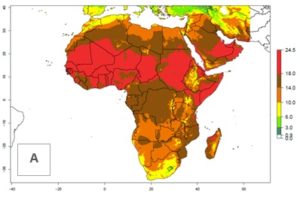 |
 |
| 2050 | 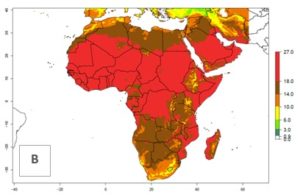 |
 |
| Index change (2000 – 2050) | 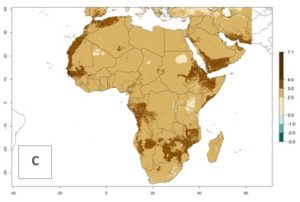 |
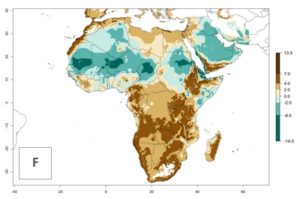 |
Figure 5. Changes in abundance (GI, damage potential) and activity (AI, potential population growth) of the vegetable leafminer fly, Liriomyza sativae, in Africa according to model predictions, using the GI (A, B) and the AI (D, E) for the years 2000 and 2050, and the absolute index change (C, F).
Country Risk Maps
Under the present climate, L. sativae presents the highest risk for Cameroon, DR Congo, Nigeria, and Sudan, which is associated with an ERI>0.95, a GI>14 generations per year, and an AI>20 (Fig. 6a, b, f, h). Also, a high probability of long-term establishment (ERI>0.95) is predicted in Ethiopia, Kenya, Tanzania, Uganda, and Zimbabwe; but with relatively less favorable temperatures for a potential increase in pest abundance and spread (GI>10, AI>15) (Fig. 6d, e, i, j, k). A small probability of establishment (ERI>0.7–0.9) is predicted in countries in North (Egypt) and Southern (South Africa) Africa, which present some lowland areas with relatively more favorable temperatures for increasing the pest risk (GI>6, AI>5) (Fig. 6c, g).
| ERI | GI | AI |
| a) Cameroon | ||
| b) Congo | ||
| c) Egypt | ||
| d) Ethiopia | ||
| e) Kenya | ||
| f) Nigeria | ||
| g) South Africa | ||
| h) Sudan | ||
| i) Tanzania | ||
| j) Uganda | ||
| k) Zimbabwe |
Figure 6. ERI, abundance (GI, potential damage), and activity (AI, potential population growth) of the vegetable leafminer fly, Liriomyza sativae, in selected African countries according to model predictions for the year 2000. An ERI>0.7 is associated with potential permanent establishment.
Phytosanitary measures
All stages are killed within a few weeks by cold storage at 0°C. Newly laid eggs are, however, the most resistant stage. It is recommended that cuttings of infested ornamental plants be maintained under normal glasshouse conditions for 3–4 days after lifting to allow eggs to hatch. Subsequent storage of the plants at 0°C for 1–2 weeks should then kill off the larvae of leaf miner species. To avoid the introduction of L. sativae (and the other leaf miner species L. huidobrensis and Amauromyza maculosa), EPPO recommends that propagating material (except seeds) of Capsicum, carnations, celery, chrysanthemums, Cucumis, Gerbera, Gypsophila, lettuces, Senecio hybridus, and tomatoes from countries where the pest occurs must have been inspected at least each month during the previous 3 months and found free from the pest. A phytosanitary certificate should be required for cut flowers and for vegetables with leaves.
Adaptation to risk avoidance at farm level
Management strategies are similar for all different species of Liriomyza attacking vegetables (see section 4.3.1). Some specific details have to be mentioned for the use of control thresholds. Semi-field studies in vegetables in Vietnam have shown that the action threshold for L. sativae varies with host plants. To avoid crop loss, control methods (e.g., the use of an insecticide) should be applied when the number of mines per leaf exceeds 5 in French bean, 1 in cowpea, 6 in pack-choi cabbage, 6 in cucumber, and 15 in tomato. In California, the damage threshold of L. sativae in tomato is 1 active leaf miner per three terminal leaflets, or 25 miners per 18 leaflets.
Further reading
CABI. 2014b. Liriomyza sativae. Invasive Species Compendium: Datasheets, maps, images, abstracts and full text on invasive species of the world. http://www.cabi.org/isc/ datasheet/30960
Capinera, J. 2001. Vegetable leafminer: Liriomyza sativae. UF/IFAS, University of Florida, Gainesville, FL. http://entnemdept.ufl.edu/creatures/veg/leaf/vegetable_leafminer.htm
Degri, M., M. Ayuba, and K. Yoriyo. 2012. Bio-efficacy of some aqueous plant extracts and cyromazine (Trigard 169) in the management of leaf miner (Liriomyza sp.) on eggplant in the Northern Guinea Savanna of Nigeria. Nigerian journal of experimental and applied biology 13(2): 125–130.
Degri, M., I. Onu, M. Dike, and M. Ayuba. 2007. Host plants of the serpentine leaf miner, Liriomyza sativae Blanchard (Diptera: Agromyzidae) in Bauchi state, Nigeria. Nigerian Journal of Entomology 24: 122–130.
Dempewolf, M. 2004. Arthropods of Economic Importance – Agromyzidae of the World (CD-ROM). ETI. University of Amsterdam, Amsterdam, Netherlands. Available from http://wbd.etibioinformatics.nl/bis/agromyzidae.php
El-Serwy, S.A. 2007. Studies on the leafminer: Liriomyza sativae (Blanchard) and Liriomyza congesta (Becker) (Diptera: Agromyzidae) and their parasitoids in Egyptian clover field. Egyptian Journal of Agricultural Research 85(5): 1613–1628.
European Plant Protection Organisation (EPPO). 2014d. Liriomyza sativae. PQR–EPPO database on quarantine pests. European and Mediterranean Plant Protection Organization. Available from http://www.eppo.int
EPPO. 1997. Liriomyza sativae. EPPO Data Sheet on Quarantine Pests. www.eppo.int/QUARANTINE/insects/ Liriomyza_sativae/LIRISA_ds.pdf
Gitonga, Z., A. Chabi-Olaye, D. Mithöfer, J. Okello, and C. Ritho. 2010. Control of invasive Liriomyza leafminer species and compliance with food safety standards by small scale snow pea farmers in Kenya. Crop Protection 29(12): 1472–1477.
Malipatil, M., and P. Ridland. 2008. Liriomyza sativae. Polyphagous Agromyzid leafminers- Identifying polyphagous agromyzid leafminers (Diptera: Agromyzidae) threatening Australian primary industries. The Department of Agriculture, Fisheries and Forestry. Available from http://keys.lucidcentral.org/keys/v3/leafminers/index.htm
Martinez, M., and D. Bordat. 1996. Note on the occurrence of Liriomyza sativae Blanchard in Sudan and Cameroon (Diptera, Agromyzidae). Bulletin de la Société Entomologique de France 101(1): 71–73.
Petitt, F.L. 1990. Distinguishing larval instars of the vegetable leafminer Liriomyza sativae (Diptera: Agromyzidae). Florida Entomologist 73(2): 280–286.
Sæthre, M.G. 1996. Pest risk assessment (PRA) for the vegetable leafminer Liriomyza sativae. Planteforsk report, 30 pp.
Spencer, K.A. 1973. Agromyzidae (Diptera) of economic importance. Agromyzidae (Diptera) of economic importance. The Hague, Netherlands: Dr. W. Junk B.V., 418 pp.
Spencer, K.A., and G.C. Steyskal. 1986. Manual of the Agromyzidae (Diptera) of the United States. USDA, ARS Agriculture Handbook No. 638, 478pp.
Walker, K. 2005. Vegetable leaf miner (Liriomyza sativae). Available from http://www.padil.gov.au:80/pests-and-diseases/Pest/Main/136215

